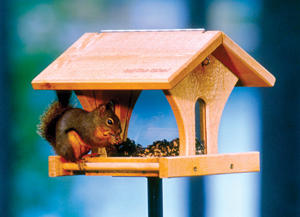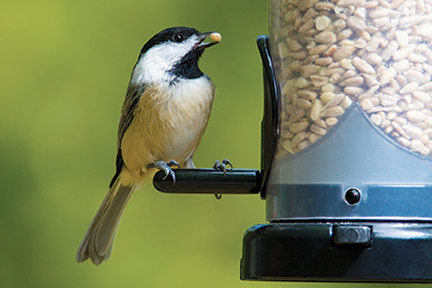Feed 'Em or Defeat 'Em
They may have a reputation for making bird feeding less enjoyable, however, squirrels aren’t going away any time soon. Perhaps by looking at them from a different perspective, you can begin to appreciate, if not enjoy, squirrels and their behaviors.
Squirrels are one of the most curious and adaptable animals to be found anywhere and they are unmatched in their problem-solving ability to defeat many so-called "squirrel proof" feeders! 
Squirrels can jump up to five feet vertically and ten feet between trees or structures. They have the ability to cling from objects with their back foot toes (with support from their tail) which allows them to hang upside-down and eat.
They certainly keep our Certified Bird Feeding Specialists on their toes in order to provide you with the latest and greatest advice on how to keep your bird food and feeders safe from these rascally rodents!
So, if you want to keep squirrels from bothering your bird feeding setup, we have the foods, feeders and accessories to confuse and confound even the most brilliant squirrel in your neighborhood.
And if you decide to raise the white flag and enjoy their amazing antics, we have lots of fun and functional squirrel feeders that will brighten up both their day and yours, too.
Visit us soon, and we’ll help you feed the squirrels if that’s your thing, or we’ll help you defeat ’em once and for all.
Fun Facts About Squirrels
- Adult Squirrels can consume about one and a half pounds of seeds and nuts each week, which is roughly the equivalent of their own body weight.
- Squirrels’ favorite natural foods are hickory nuts, pecans, black walnuts, and acorns. Their favorite feeder food is black oil sunflower seeds, their least favorite feeder food is Nyjer® (thistle) seed.
- A 19-inch-long gray squirrel has a seven-foot-long digestive track that enables it to utilize a wide variety of foods including tree fruits, insects, bird eggs and mushrooms.
- Squirrels must drink water at least twice per day.
- A squirrel’s scalpel-sharp incisors grow about six inches per year. As with all the other members of the rodent family, squirrels must constantly gnaw on hard materials to keep them worn down and to sharpen them.
- In an hour’s time, a squirrel can collect and bury 25 nuts. Unable to remember each nut’s location, they find them again by using a highly developed sense of smell.
- During a harsh winter a squirrel may loose up to 25% of its body weight.
- Most squirrels are active in the winter only around mid-day, during the remainder of the year they are early risers with a peak activity period during the two hours after sunrise and again during the mid-afternoon.
- The name “squirrel” originates from the Greek words for shade and tail.
- Squirrels will have a litter of three to four young around early January and again in early August. The average life expectancy of these youngsters in the wild is approximately one year, although some captive squirrels have lived up to 15 years.
- Squirrels may den in the ground, tree cavities, and in nests they construct that are called dreys. Summer dreys are located in tree branches and consist of twigs and leaves. Winter dreys are waterproof and have a lining of bark, lichen, moss, fur and leaves.
- Squirrels can jump up to six feet vertically and eight feet between trees or structures. Placing feeders and baffles outside of their jumping range will help to deter them.
- The Gray Squirrel uses its tail as a shield when fighting, as a blanket in cold weather, and, sometimes, as an umbrella during rain storms.
- The Gray Squirrel weighs only ½ an ounce at birth and reaches its adult size six months later.
- The Gray Squirrel stocks its winter pantry by burying up to 10,000 nuts each fall. It also feeds on grapes, fungi, grasses, larval and adult insects, and amphibians.
- The Fox Squirrel sweats through its paws. During hot weather, it will actually leave damp tracks on a dry surface.

